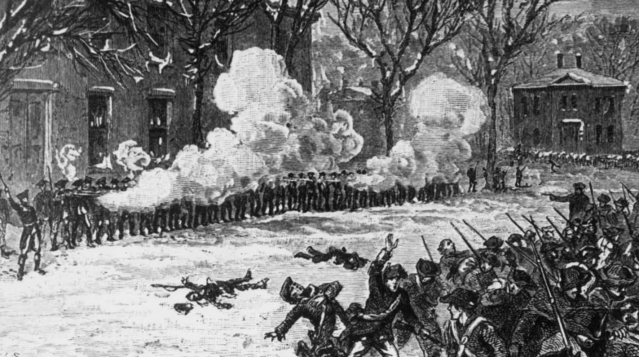
Government troops fire on Shays’ Rebellion (cite unknown)
I keep seeing these fairy tales about the origins of the Second Amendment — that its purpose was to guard against the tyranny of the government by enshrining an individual’s right to own a gun.
The Constitution was ratified in reaction to the weakness of the Articles of Confederation. A bunch of ragtag former colonies had somehow managed to wear down the British over five years under a skeletal cooperation agreement, during which the Continental Congress spent much of its time pleading for money from the 13 former colonies.
Then critics managed to convince the states to appoint delegates to a constitutional convention separate from the state legislatures, which were jealous of their sovereignty. They met in secret and came up with a plan that barely achieved ratification. Thus the United States was born.
Virginia and New York were the last of the 11 states that with varying reservations put the Constitution into effect (it required nine but practically could not have succeeded without those two), and Rhode Island and North Carolina were still recalcitrant. So during the First Congress, while Hamilton was constructing the executive branch and Madison was pushing legislation through the House to create a government from scratch, Madison also convinced Congress to take up the Bill of Rights (originally 12 amendments but finally 10).
The First and Fourth through Eighth are a logical piece of poetry about the rights of individuals. The Ninth and Tenth are about the relationship between the states and the federal government. The Second and Third dealt with problems that had confronted the colonies/states.
The Third, which we never talk about anymore, prevented the government from housing soldiers in your home — a cause of the revolution. It’s the forgotten amendment.
The Second was forgotten for more than 150 years. Its purpose was to ensure that the federal government, which barely functioned and was in debt (to Americans, British merchants, the French, etc.), had access to a standing army to confront enemies foreign and domestic. And there were both.
The British, still pissed about their humiliating defeat, continued to foment trouble on the western frontier. Domestically, throughout the post-war period, the states and their people were angry about paying taxes (some things never change).
In 1786-87, Daniel Shays led a band of rebels against the government of Massachusetts over taxes. Shays’ Rebellion drove General Washington out of retirement. The Constitutional Convention followed shortly.
So the Second, in a period while Congress hadn’t even gotten to the argument about whether to have an army, was intended to create an alternative: “A well regulated Militia, being necessary to the security of a free State, the right of the people to keep and bear Arms, shall not be infringed.” The idea was that the states could be called upon to support the feds. It was not so that people would have the right to prosecute an insurrection against the government that THESE LEADERS HAD JUST CREATED.
After The Federalists were dispatched in 1800, Jefferson came to see that a standing army and navy was a good idea, handy for fighting on the shores of Tripoli. His successors found them useful for battling Britain and soon enough Indians. State militias were the backbone of the Civil War.
We went along that way, thinking no more of the Second than of the Third until the 1970s when, after an internal battle at the NRA that coincided with a period of domestic unrest and the truncated reign of a “law and order” president with paranoid tendencies, an argument was conceived that the amendment was about protecting your right to own a gun. That hadn’t been an issue for 350 years in a country whose expansion was forged at the barrel of a gun, individually and collectively.
And now we have a Gun Manufacturers Association whose purpose is to sell guns by stoking fear of your fellow countrymen. Next up: arm teachers. Because the only way to stop a bad man with a gun is to have a good man with a gun.
Tell that to Ronald Reagan’s Secret Service detail.

Solid historical analysis. And semantic analysis. We forget how conservative the Constitutional Convention was. And why the amendment is one sentence, where one can’t separate having a weapon from the relationship (real or potential) with an official State militia.
LikeLike